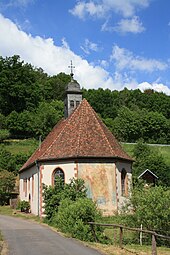Amorsbrunn

Amorsbrunn is a chapel in the town of Amorbach in Lower Franconia (Bavaria), which was built over an earlier spring cult site. The oldest surviving components date from the 12th century. The spring under the chapel pours four liters of water per second and feeds the Otterbach , which is often dry above this point and is called Amorbach from here on .
etymology
The source location takes its name like the eponymous city from the Amorbach water body . Its first component does not come from the Latin word "amor" for love or the eponymous divine name Amor , but from the medieval word "amar", which denoted the emmer . The brook was named Amerbach in 788 , Ammerbach in 1144 and Amorbach in 1336 . The current name came about through folk etymological reinterpretation.
History and legend of saints
The Amorsbrunn spring cult site is probably of Roman or Germanic origin and was later Christianized .
Amorsbrunn became famous in the 11th century when the Amorbach monk Theodorich von Fleury named the site “Sancti amoris fons” after a gout cure in Amorbach, which literally means “healing source of divine love”; since “amor” is written in lower case, it is obviously not a proper name here. The Church's patroness is Mary , the Mother of God .
Since around 1443, the world priest Johannes Keck, who was born in Rothenburg ob der Tauber , stayed in Amorbach Abbey for several years. He declared Amorbach for the first time to found a St. Amor, who after his martyrdom is buried in Münsterbilsen near Maastricht in Limburg . He is said to have Christianized the sanctuary in 734. In order to consolidate this interpretation, Keck traveled to the Netherlands in 1443/1444 accompanied by a farmer Gerlach from Neudorf with letters of recommendation from the abbot to the abbess of Münsterbilsen. They brought back a number of the saint's relics , as well as precise descriptions or a drawing of the way St. Amor is depicted there. In 1446 a statue of the saint was made, which is still on the left in the church choir . The relics were in a likewise still visible, closed with an iron door shrine recovered. At that time there were also relics of St. Landrada was brought to Amorbach. A stone block at the entrance with the so-called "Landradakreuz" reminds of her, and by the way her cult has not become at home with us.
Amorsbrunn today
Today Amorsbrunn is a popular destination for pilgrims and pilgrims as well as a place to get married all over Europe. The chapel can be visited from May 1st to October 30th between 10:00 and 17:00.
The altar (around 1500) with a representation of the root of Jesse as well as Joachim and Anna , the parents of Mary .
Free-standing pulpit in front of the chapel
Depiction of St. Christopher
literature
- Norbert Wand: Sancti Amoris fons. The hermitage and pilgrimage chapel Amorsbrunn near Amorbach . In Ders .: Medieval hermitages, spring shrines and pilgrimage sites in the Odenwald . Laurissa, Heppenheim 1995, ISBN 3-922781-51-9 , p. 36f.
- Walter Hotz : Amorbacher Cicerone. Art-historical guide through the abbey and town with Amorsbrunn, Gotthard, Wildenberg, Waldleiningen and the parish villages . 5th edition, Emig, Amorbach 1976.
Web links
- " The source cult site Amorsbrunn in the Odenwald " on the website heilige-quellen.de by Klaus Kramer
- Amorsbrunn in the location database of the Bavarian State Library Online . Bavarian State Library
Individual evidence
- ^ Wolf-Armin von Reitzenstein : Lexicon of Franconian place names. Origin and meaning . Upper Franconia, Middle Franconia, Lower Franconia. CH Beck, Munich 2009, ISBN 978-3-406-59131-0 , p. 25 ( limited preview in Google Book search).
- ↑ a b c The source cult site Amorsbrunn in the Odenwald. heilige-quellen.de, accessed on May 11, 2014 .
Coordinates: 49 ° 38 ′ 54.5 ″ N , 9 ° 12 ′ 2 ″ E





